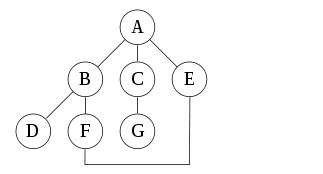圖的深度優先搜索類似于樹的深度優先搜索。不同的是,圖中可能包括循環,即我們有可能重復訪問節點。為了避免訪問已經訪問過的節點,我們要使用一個布爾變量的數組。
例如,在下圖中,我們從節點2開始訪問。當訪問到節點0,我們尋找它的所有緊接節點。節點2也屬于節點0的鄰接節點。如果我們沒有標記訪問的節點,那么節點2 將會被重復訪問,這樣的話整個算法過程就不會停下來了。下圖的深度優先搜索是2,0,1,3

這種搜索算法所遵循的搜索策略是盡可能“深”地搜索一個圖。它的基本思想如下:首先訪問圖中某一起始頂點v,然后由v出發,訪問與v鄰接且未被訪問的任一頂點w1,再訪問與w1鄰接且未被訪問的任一頂點w2,......重復上述過程。當不能再繼續向下訪問時,一次退回到最近被訪問的頂點,若它還有鄰接頂點未被訪問過,則從該點開始繼續上述搜索過程,直到圖中所有頂點均被訪問過為止。
舉個例子:

上圖一幅無向圖。我們從A點開始遍歷,并假設左邊的節點先被訪問到。那么訪問順序是A,搜索A所有可訪問的鄰接節點并選擇B,然后訪問B,搜索B所有可訪問的鄰接節點并選擇D,然后訪問D,搜索D的所有可訪問的鄰接節點。由于D只有一個鄰接節點B,而B已經被訪問過。所以回退到D的上級B(注意,不是訪問B,僅僅是回到上級)。然后再搜索B的所有可訪問的鄰接節點,AD已經被訪問過,所以訪問F。這個過程一直持續直到訪問過所有的節點。
選擇可訪問鄰接節點的時候,可以使用我們自己定義的順序。比如訪問A的鄰接節點的時候,可以先訪問B,也可以先訪問E。可根據需求靈活調整。
?
下述代碼是深度優先搜索的C++版本,有遞歸和迭代版本。圖的實現使用鄰接鏈表表示。STL的list被用來存儲鄰接節點。
#include<list> #include<iostream> using namespace std;class Graph {private:int V;list<int>* adj;void DfsUtil(int v, bool visited[]);public:Graph(int n); //No of vertices~Graph(); //Pointer to an array containing adjacency listsvoid addEdge(int v, int w); //function to add an edge to graphvoid Dfs(int s); //Dfs traversal of the vertices reachable from vvoid DfsIter(int s); };Graph::Graph(int v) {V = v;adj = new list<int>[V]; }Graph::~Graph() {delete []adj;adj = NULL; }void Graph::addEdge(int v, int w) {adj[v].push_back(w); //Add w to v's list }void Graph::Dfs(int s) {bool* visited = new bool[V];for (int i = 0; i < V; i++)visited[V] = false;DfsUtil(s, visited); }void Graph::DfsUtil(int v, bool visited[]) {//Mark the current node as the visited and print itvisited[v] = true;cout<<v<<" ";//Recur for all vertices adjacent to this vertexlist<int>::iterator i;for (i = adj[v].begin(); i != adj[v].end(); i++)if (!visited[*i])DfsUtil(*i, visited); }void Graph::DfsIter(int v) {bool* visited = new bool[V];for (int i = 0; i < V; i++)visited[i] = false;list<int> stack;stack.push_back(v);list<int>::iterator i;while (!stack.empty()) {v = stack.back();cout<<v<<" ";stack.pop_back();visited[v] = true;for(i = adj[v].begin(); i != adj[v].end(); i++)if (!visited[*i])stack.push_back(*i);} delete []visited; }int main() {// Create a graph given in the above diagramGraph g(4);g.addEdge(0, 1);g.addEdge(0, 2);g.addEdge(1, 2);g.addEdge(2, 0);g.addEdge(2, 3);g.addEdge(3, 3);cout << "Following is Depth First Traversal (starting from vertex 2) \n";g.DfsIter(2);return 0; }
?
輸出:
Following is Depth First Traversal (starting from vertex 2) 2 0 1 3
?
參考資料:
1. http://www.geeksforgeeks.org/depth-first-traversal-for-a-graph/
 .)



:具體、抽象函數的導數、微分與方向導數的計算...)


 JavaEE架構)

)









